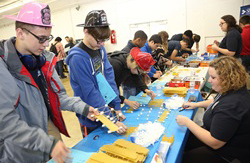

 The Virginia Department of Transportation (VDOT) Northern Virginia District held its 12th annual Transportation Career Fair Thursday, Oct. 6, at the Prince William County Fairgrounds, in Manassas, VA.
The Virginia Department of Transportation (VDOT) Northern Virginia District held its 12th annual Transportation Career Fair Thursday, Oct. 6, at the Prince William County Fairgrounds, in Manassas, VA.
A record 1,500 area high school students attended the event where there were numerous hands-on opportunities for students, including networking with employers, trying equipment, learning how to build a bridge and a demonstration on how concrete is made. The CVI-UTC and VTTI were among approximately 100 engineering firms, organizations, agencies and contractors from across Virginia which encouraged students to learn about careers in transportation-related fields, such as civil engineering, architecture, technology, construction and environmental engineering.
Learn more about this event here.
The final report for Measuring User Acceptance and Willingness To Pay for CVI Technology, submitted by Dr. Hyeon-Shic Shin, Dr. Michael Callow, Dr. Z. Andrew Farkas, Dr. Young-Jae Lee, and Seyedehsan Dadvar, has been released.
The increased prevalence of Connected Vehicles (CVs) is expected to provide significant safety benefits to roadway users. Estimates indicate that the use of CVs will reduce non-impaired driver crashes by 80 percent. To ensure that the full benefits of CVs are realized, it is critical for transportation professionals to develop effective deployment strategies. However, the large number of unknowns currently makes this difficult. For instance, there are (1) no clear-cut deployment strategies due to a methodological void; (2) overly optimistic adoption estimates; and (3) no unified roadmaps to which state and local governments must conform. Current studies suggest that understanding drivers’ perceptions, needs, and acceptance of CVs will provide rich information for solving these unknowns. As price is a serious barrier to CV technology proliferation, the primary goal of the current study is to use an adaptive choice-based conjoint analysis to estimate drivers’ acceptance of and willingness to pay (WTP) for CVs through a simulation of participants’ purchasing decisions. Results show that, with regard to the acceptance of safety features, acceptance of “collision warning packages” was the highest. Comparisons of WTP considering several socioeconomic variables found that drivers between the ages of 40 and 49 years, African-Americans, those with less than a bachelor’s degree, and those with a higher budget for vehicle purchase were positively related to WTP. Results also indicate that, at every age, women are more concerned about safety than are men. While the study did not find statistical differences in WTP between men and women, women’s budgets for vehicle purchases were lower than men’s, and women reported significantly less prior knowledge of CVs. Also, women 50 and older appear less interested in CV technologies. As a result of these findings, the research team suggests that government agencies showcase CV technologies’ safety benefits via media catering to mature women and at family-oriented public events.
Click here to learn more about this project and read the final report.
The final reports for Applications of Connected Vehicle Infrastructure Technologies to Enhance Transit Service Efficiency and Safety, submitted by (1) Dr. Kathleen Hancock and (2) Dr. Young-Jae Lee, Clayton Thomas, and Seyedehsan Dadvar, has been released.
(Final Report 1) Implementing Connected Vehicle Infrastructure (CVI) applications for handheld devices into public transportation transit systems would provide transit agencies and their users with two-directional information flow from traveler-to-agencies, agencies-to-traveler, traveler-to-vehicle, and vehicle-to-traveler. This information flow could improve the efficiency of services provided by the agency and enhance the safety of travelers and drivers. This project developed an architectural framework for two CVI applications: (1) an application for dynamic demand-response transit (DRT) services and (2) an enhanced traveler safety application that allows individuals to notify a transit vehicle that they are within a specified distance of the vehicle’s current stop location. A limited simulation was performed to evaluate the potential of using this location information with respect to a transit vehicle to provide flexibility for that vehicle to remain at a stop for a limited time, minimizing passenger wait time and exposure to potential safety issues, specifically during night operations. An annotated bibliography of resources used for this study is also provided.
(Final Report 2) Many transit agencies provide real-time operational information and trip-planning tools through phone, Web, and smartphone applications. These services utilize a one-way information flow from transit agencies to transit users. Current smartphone technology and connected vehicle infrastructure (CVI), however, can allow a two-directional information flow from users to transit agencies and back. This report provides a literature review on the state of current transit apps; proposes a system architecture for a smartphone app that allows for dynamic flexible routing and increased transit user safety; and presents the results of a survey conducted on the perception and acceptability of the model app. Survey results were analyzed in terms of safety, efficiency, and privacy for different demographic, travel behavior, and geographic characteristics. Results showed that users did not significantly consider the privacy issues (7.1 on a scale from 1 [least acceptable] to 10 [most acceptable]) but believed that it could improve nighttime safety (7.3/10.0). Users believed that the app could improve nighttime pedestrian safety if it were connected to the police department (7.8/10.0). This app was also expected to improve transit efficiency and increase ridership, and is eventually recommendable (7.3/10.0). The least expected improvement was daytime safety (6.4/10.0), which is reasonable and expectable.
Click here to learn more about this project and read the final reports.
The mission statement of the Connected Vehicle/Infrastructure University Transportation Center (CVI-UTC) is to conduct research that will advance surface transportation through the application of innovative research and using connected-vehicle and infrastructure technologies to improve safety, state of good repair, economic competitiveness, livable communities, and environmental sustainability.
 Dr. Thomas A. Dingus serves as the director for the CVI-UTC, as well as the director of the Virginia Tech Transportation Institute (VTTI) and the National Surface Transportation Safety Center for Excellence (NSTSCE). Prior to joining Virginia Tech, Dr. Dingus was founding director of the National Center for Transportation Technology at the University of Idaho and was an associate director of the Center for Computer-Aided Design at the University of Iowa. Dr. Dingus has more than 220 technical publications and has managed approximately $300 million in research funding to date ($130 million as principal investigator).
Dr. Thomas A. Dingus serves as the director for the CVI-UTC, as well as the director of the Virginia Tech Transportation Institute (VTTI) and the National Surface Transportation Safety Center for Excellence (NSTSCE). Prior to joining Virginia Tech, Dr. Dingus was founding director of the National Center for Transportation Technology at the University of Idaho and was an associate director of the Center for Computer-Aided Design at the University of Iowa. Dr. Dingus has more than 220 technical publications and has managed approximately $300 million in research funding to date ($130 million as principal investigator).
